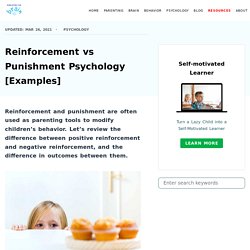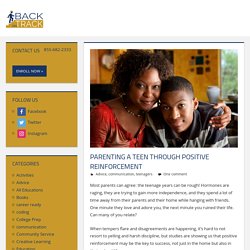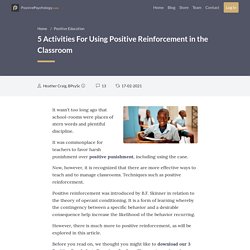

What is Reinforcement and Punishment. Reinforcement VS Punishment. Reinforcement and punishment are often used as parenting tools to modify children’s behavior.

Let’s review the difference between positive reinforcement and negative reinforcement, and the difference in outcomes between them. The Difference Between Positive And Negative Reinforcement In behavioral psychology, reinforcement is the introduction of a favorable condition that will make the desired behavior more likely to happen, continue or strengthen in the future1. Because the favorable condition acts as a reward, reinforcement is a reward-based operant conditioning. The Difference between Positive/Negative Reinforcement and Positive/Negative Punishment. February 5, 2013 7:40 pm Published by Kelley Prince M.A., BCBA In Applied Behavior Analysis, there are two types of reinforcement and punishment: positive and negative.

It can be difficult to distinguish between the four of these. Therefore, the purpose of this blog is to explain the differences in order to help parents and professionals develop appropriate interventions to improve behavior. Reinforcement Reinforcement is used to help increase the probability that a specific behavior will occur in the future by delivering or removing a stimulus immediately after a behavior.Another way to put it is that reinforcement, if done correctly, results in a behavior occurring more frequently in the future.
Reinforcement and Punishment: Examples & Overview. The power of reinforcement and punishment to change behavior was discovered by B.F.

Video on Operant Conditioning. Understanding Teen Behaviour. What is Considered Normal Teenage Behavior? - Paradigm Treatment. A decade or more ago, you made it through the “terrible twos” with your child.

Now that he or she is a teenager, you might feel as though you’re playing a whole other ballgame. Teenage Behaviour Problems. Teen issues Is your teenager violent, depressed, abusing alcohol or drugs, or facing other problems?

Here’s how to ease the stress at home and help your teen transition into a happy, successful adult. Why do teens act the way they do? Parenting a teenager is never easy. Video: Understanding Teen Behaviour. Typical vs. Abnormal Teen Behavior. Adolescence is a time of change.

The changes can be so dramatic that it leaves parents wondering if what they are seeing is just typical teen behavior or cause for concern. The American Academy of Child and Adolescent Psychiatry (AACAP) reports that the teenage years are marked by trying on independence through experimentation. Positive Reinforcement for Teens. By the time children have reached adolescence, their responses are often ingrained, but parental actions can still positively affect adolescent behavior. Since adolescents are struggling to develop their personal identity and are concerned about their body image, parental support is crucial to help positively frame experiences as learning opportunities. Positive reinforcement remains a powerful teaching tool during these formative years, and we encourage parents to take time to contemplate the ways they can help adolescents mature and become self-reliant.
Reinforce mature decisions by allowing increased privileges when adolescent demonstrates increased responsibility. For instance, an adolescent who consistently demonstrates the ability to come home at the requested time might be allowed a later curfew - whereas an adolescent who has not completed requested chores will not be allowed to leave home that evening.Express pleasure at positive adolescent behavior. How to Reward Your Teen for Good Behavior. Teenagers are young adults who are trying to learn the ways of the world.

When they do something great at school or at home or simply make a healthy decision, parents can give them a reward. Parenting A Teen Through Positive Reinforcement - Back On Track. Most parents can agree: the teenage years can be rough!

Hormones are raging, they are trying to gain more independence, and they spend a lot of time away from their parents and their home while hanging with friends. One minute they love and adore you, the next minute you ruined their life. Can many of you relate? When tempers flare and disagreements are happening, it’s hard to not resort to yelling and harsh discipline, but studies are showing us that positive reinforcement may be the key to success, not just in the home but also in their school life. We’ve all heard the saying, “The one who is hardest to love needs love the most.”
Benefits of Positive Reinforcement for Teens. As children approach adolescence, they sometimes begin testing limits, bending the rules and otherwise going against the grain.

While this is normal behaviour for teens, it can be incredibly trying for you, as a parent. Teenagers may also be dealing with the stresses that come with trying to fit in with their peers and assert their growing independence. However, at the same time, they are looking for validation from the adults around them. 5 Activities For Using Positive Reinforcement in the Classroom.
It wasn’t too long ago that school-rooms were places of stern words and plentiful discipline.

It was commonplace for teachers to favor harsh punishment over positive punishment, including using the cane. Now, however, it is recognized that there are more effective ways to teach and to manage classrooms. Techniques such as positive reinforcement. Positive reinforcement was introduced by B.F. Skinner in relation to the theory of operant conditioning. Good Punishment for Teens: Strategies and Challenges. When your child becomes a teenager, your parenting role is likely to shift. You may find yourself becoming more of a guide, rather than an enforcer. Effective Consequences for Teenagers.
If you’re having trouble giving effective consequences to your teen, know that you are not alone. Many parents tell me that nothing seems to work, and that coming up with the right thing for their child can seem like an impossible task. If you’re the parent of an adolescent, you may have grounded your child, taken away their video games, or suspended their driving privileges for months on end.
But as James Lehman says, you can’t punish kids into acceptable behavior—it just doesn’t work that way. Creative Consequences. Menu Search Close Share what kind of mom you are! Get to know other mom types! Ages + Stages, Elementary Kids 21 Creative Consequences Share on facebook Share on twitter Share on pinterest Share on email. Positive Punishment: What It Is, Benefits, and Examples.
Positive punishment is a form of behavior modification. In this case, the word “positive” doesn’t refer to something pleasant. Positive punishment is adding something to the mix that will result in an unpleasant consequence. The goal is to decrease the likelihood that the unwanted behavior will happen again in the future. This approach may be effective in certain circumstance, but it’s only one part of the equation. Reinforcement sensitivity, coping, and delinquent behaviour in adolescents. Abstract Since 1964, the relationship between personality and criminal behaviour has been extensively studied. Classroom Strategies for Increasing Positive Behaviours. The modification of delinquent behaviour through operant conditioning.